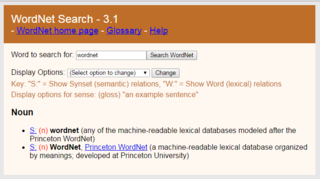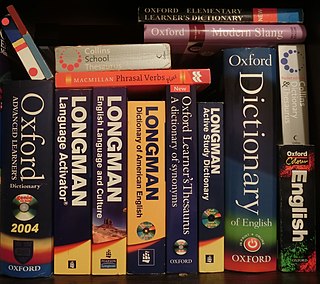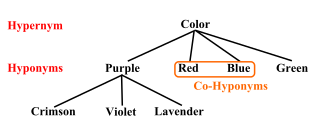| Look up lexical in Wiktionary, the free dictionary. |
Lexical may refer to:
| Look up lexical in Wiktionary, the free dictionary. |
Lexical may refer to:
| This disambiguation page lists articles associated with the title Lexical. If an internal link led you here, you may wish to change the link to point directly to the intended article. |
A lexicon, word-hoard, wordbook, or word-stock is the vocabulary of a person, language, or branch of knowledge. In linguistics, a lexicon is a language's inventory of lexemes. The word lexicon derives from the Greek λεξικόν, neuter of λεξικός meaning 'of or for words'.
Lexicology is the part of linguistics that studies words. This may include their nature and function as symbols, their meaning, the relationship of their meaning to epistemology in general, and the rules of their composition from smaller elements . Lexicology also involves relations between words, which may involve semantics, derivation, use and sociolinguistic distinctions, and any other issues involved in analyzing the whole lexicon of a language.
Semantics is the study of meaning, reference, or truth. The term can be used to refer to subfields of several distinct disciplines including linguistics, philosophy, and computer science.

WordNet is a lexical database of semantic relations between words in more than 200 languages. WordNet links words into semantic relations including synonyms, hyponyms, and meronyms. The synonyms are grouped into synsets with short definitions and usage examples. WordNet can thus be seen as a combination and extension of a dictionary and thesaurus. While it is accessible to human users via a web browser, its primary use is in automatic text analysis and artificial intelligence applications. WordNet was first created in the English language and the English WordNet database and software tools have been released under a BSD style license and are freely available for download from that WordNet website.

A noun is a word that functions as the name of a specific object or set of objects, such as living creatures, places, actions, qualities, states of existence, or ideas. However, noun is not a semantic category, so that it cannot be characterized in terms of its meaning. Thus, actions and states of existence can also be expressed by verbs, qualities by adjectives, and places by adverbs. Linguistically, a noun is a member of a large, open part of speech whose members can occur as the main word in the subject of a clause, the object of a verb, or the object of a preposition.
In traditional grammar, a part of speech or part-of-speech is a category of words that have similar grammatical properties. Words that are assigned to the same part of speech generally display similar syntactic behavior—they play similar roles within the grammatical structure of sentences—and sometimes similar morphology in that they undergo inflection for similar properties.

An idiom is a phrase or expression that typically presents a figurative, non-literal meaning attached to the phrase; but some phrases become figurative idioms while retaining the literal meaning of the phrase. Categorized as formulaic language, an idiom's figurative meaning is different from the literal meaning. Idioms occur frequently in all languages; in English alone there are an estimated twenty-five thousand idiomatic expressions.
In lexical semantics, opposites are words lying in an inherently incompatible binary relationship. For example, something that is long entails that it is not short. It is referred to as a 'binary' relationship because there are two members in a set of opposites. The relationship between opposites is known as opposition. A member of a pair of opposites can generally be determined by the question What is the opposite of X ?
Polysemy is the capacity for a word or phrase to have multiple meanings, usually related by contiguity of meaning within a semantic field. Polysemy is thus distinct from homonymy—or homophony—which is an accidental similarity between two words ; while homonymy is often a mere linguistic coincidence, polysemy is not. In deciding between polysemy or homonymy, it might be necessary to look at the history of the word to see if the two meanings are historically related. Dictionary writers list polysemes under the same entry; homonyms are defined separately.

In linguistics, a hyponym is a word or phrase whose semantic field is included within that of another word, its hyperonym or hypernym. In simpler terms, a hyponym is in a type-of relationship with its hypernym. For example, pigeon, crow, eagle and seagull are all hyponyms of bird ; which itself is a hyponym of animal.
Lexical semantics, is a subfield of linguistic semantics. The units of analysis in lexical semantics are lexical units which include not only words but also sub-words or sub-units such as affixes and even compound words and phrases. Lexical units include the catalogue of words in a language, the lexicon. Lexical semantics looks at how the meaning of the lexical units correlates with the structure of the language or syntax. This is referred to as syntax-semantic interface.

In linguistics, a compound verb or complex predicate is a multi-word compound that functions as a single verb. One component of the compound is a light verb or vector, which carries any inflections, indicating tense, mood, or aspect, but provides only fine shades of meaning. The other, "primary", component is a verb or noun which carries most of the semantics of the compound, and determines its arguments. It is usually in either base or [in Verb + Verb compounds] conjunctive participial form.
In linguistics, a word of a spoken language can be defined as the smallest sequence of phonemes that can be uttered in isolation with objective or practical meaning. In many languages, words also correspond to sequences of graphemes ("letters") in their standard writing systems that are delimited by spaces wider than the normal inter-letter space, or by other graphical conventions. The concept of "word" is usually distinguished from that of a morpheme, which is the smallest unit of speech which has a meaning, even if it will not stand on its own.
Yāska was an early Sanskrit grammarian. Preceding Pāṇini, he is traditionally identified as the author of Nirukta, the discipline of "etymology" within Sanskrit grammatical tradition.
In historical linguistics and language change, grammaticalization is a process of language change by which words representing objects and actions become grammatical markers. Thus it creates new function words by a process other than deriving them from existing bound, inflectional constructions, instead deriving them from content words. For example, the Old English verb willan 'to want', 'to wish' has become the Modern English auxiliary verb will, which expresses intention or simply futurity. Some concepts are often grammaticalized, while others, such as evidentiality, are not so much.
Lexicalization is the process of adding words, set phrases, or word patterns to a language – that is, of adding items to a language's lexicon.
Nanosyntax is an approach to syntax where the terminal nodes of syntactic parse trees may be reduced to units smaller than a morpheme. Each unit may stand as an irreducible element and not be required to form a further "subtree." Due to its reduction to the smallest terminal possible, the terminals are smaller than morphemes. Therefore, morphemes and words cannot be itemised as a single terminal, and instead are composed by several terminals. As a result, Nanosyntax can serve as a solution to phenomena that are inadequately explained by other theories of syntax.
Language resource management - Lexical markup framework, is the ISO International Organization for Standardization ISO/TC37 standard for natural language processing (NLP) and machine-readable dictionary (MRD) lexicons. The scope is standardization of principles and methods relating to language resources in the contexts of multilingual communication.
In linguistics an accidental gap, also known as a gap, paradigm gap, accidental lexical gap, lexical gap, lacuna, or hole in the pattern, is a word or other form that does not exist in some language but which would be permitted by the grammatical rules of the language. Accidental gaps differ from systematic gaps, those words or other forms which do not exist in a language due to the boundaries set by phonological, morphological, and other rules of that specific language.
The Integrational theory of language is the general theory of language that has been developed within the general linguistic approach of integrational linguistics.